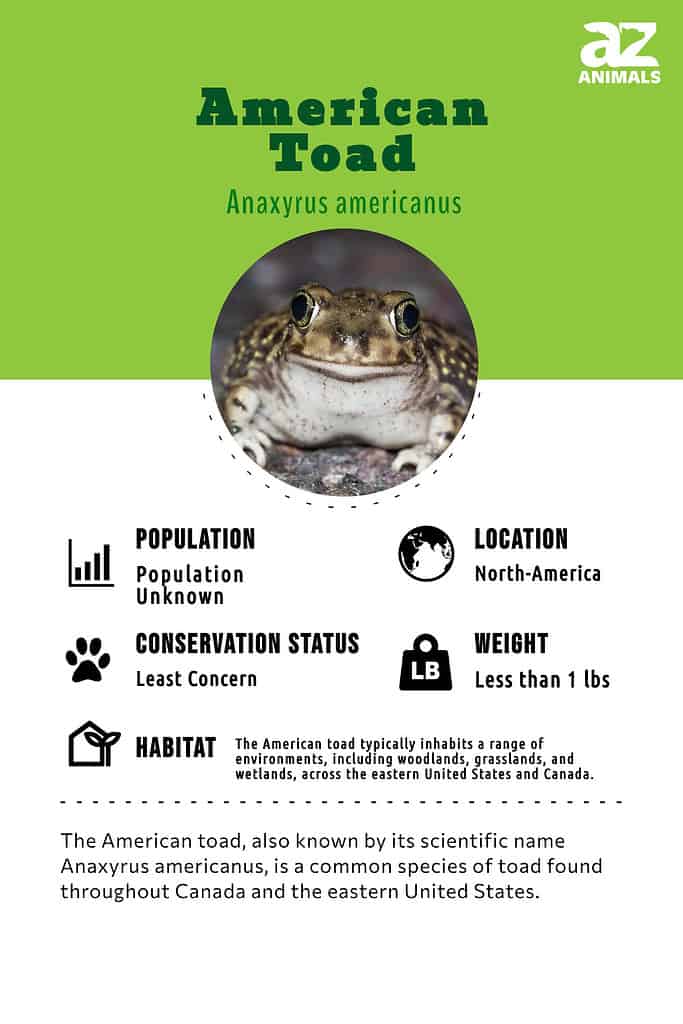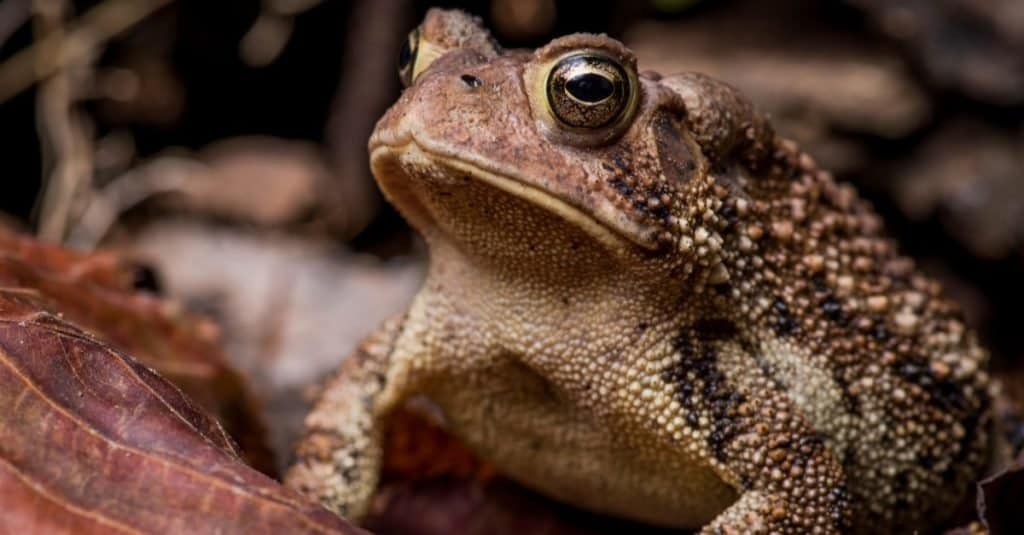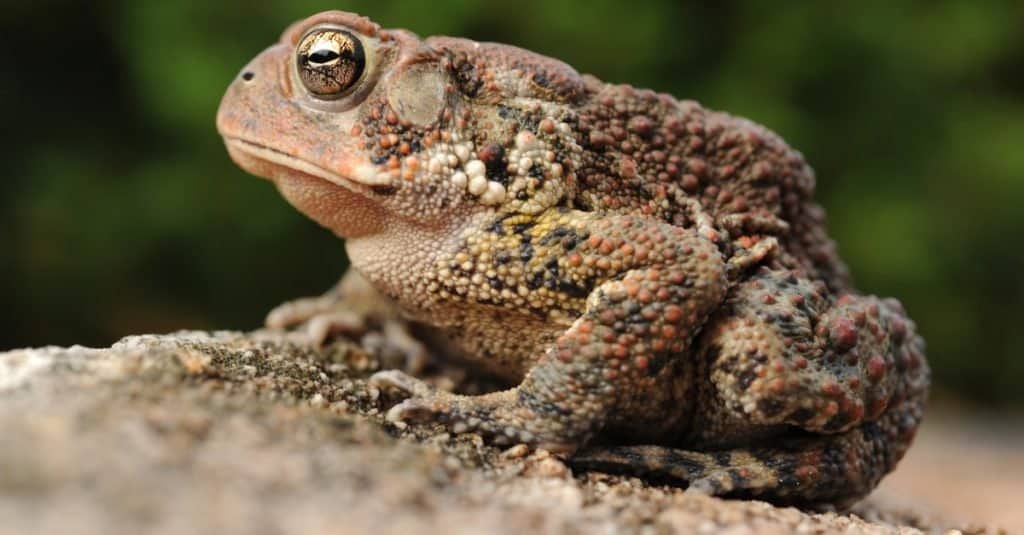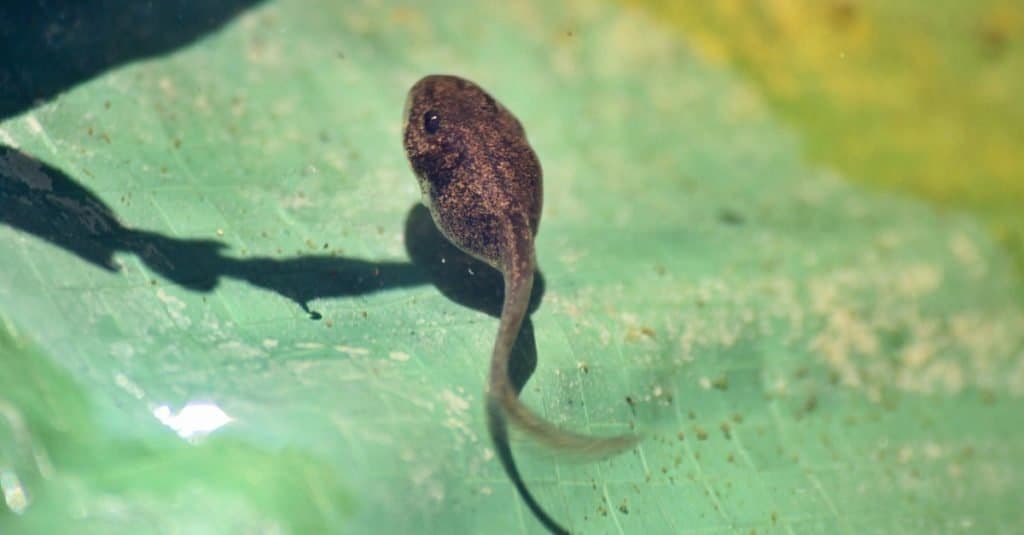American Toad
Anaxyrus americanus
They secrete a milky poisonous liquid that can make many animals sick.
Advertisement
American Toad Scientific Classification
- Kingdom
- Animalia
- Phylum
- Chordata
- Class
- Amphibia
- Order
- Anura
- Family
- Bufonidae
- Genus
- Anaxyrus
- Scientific Name
- Anaxyrus americanus
Read our Complete Guide to Classification of Animals.
American Toad Conservation Status
American Toad Facts
- Prey
- Aquatic vegetation and algae, a wide variety of insects and other invertebrates, slugs, beetles, snails, and earthworms.
- Name Of Young
- Tadpoles
- Group Behavior
- Solitary/Group
- Fun Fact
- They secrete a milky poisonous liquid that can make many animals sick.
- Estimated Population Size
- Unknown, due to constant fluctuations in different regions.
- Biggest Threat
- Snakes (Eastern hognose snakes)
- Most Distinctive Feature
- Warts on skin
- Gestation Period
- 2-14 days
- Litter Size
- 4,000-8,000 eggs
- Habitat
- Semi-permanent pool or pond, dense vegetation patches
- Predators
- Snakes (Eastern hognose snakes)
- Diet
- Omnivore
- Type
- Frog (Amphibian)
- Common Name
- American Toad
- Number Of Species
- 3
- Location
- Semi-permanent pool or pond, dense vegetation patches
American Toad Physical Characteristics
View all of the American Toad images!

The American toad is a common species of toad that are found throughout the eastern United States as well as Canada.
The American toad has three subspecies – the rare Hudson Bay toad, the Eastern American toad, and the Dwarf American toad.
These toads are characterized by noticeable warts along with their stout bodies with short legs. The warty skin on these toads is known to contain poisonous milky fluid which helps these toads with protection from their predators.
American toad vs. Fowler’s toad

To distinguish between the American toad and Fowler’s toad, you can count the number of bumps within the dark blotches on their backs.
©Viktor Loki/Shutterstock.com
To differentiate between the American toad and Fowler’s toad, one could count the number of bumps in each of the large dark blotches on the back of these toads.
While Fowler’s toads have about three or four bumps per blotch, the American toads have only one or two. Apart from that, another difference is that the belly of Fowler’s toad is white while that of an American toad is white with black spots.
5 Incredible American Toad Facts!

The toxicity of most American toads is generally low.
©Fotoz by David G/Shutterstock.com
- The female toad can lay up to 20,000 eggs which can hatch within one week.
- Most American toads are only mildly toxic.
- The tadpoles transform into adults after developing for 40 to 70 days.
- Toads attach their eggs to grass or leaves near water edges in long parallel strands that resemble strands of black beads.
- Playing dead is an effective way for toads to evade being killed by predators. The American toad is especially adept at this to evade danger.
Scientific Name

Anaxyrus americanus is the scientific name given to the American toads.
©Miles Boyer/Shutterstock.com
The American toads go by the scientific name Anaxyrus americanus. The kingdom is called Animalia and the Phylum is Chordata. The class is Amphibia, and the order is Anura. The family is called Bufonidae, and the genus is Anaxyrus. The species is called A. americanus.
While the name “Americanus” simply refers to the region in the world where these toads are found, “anaxyrus” is a Greek word that represents a king or a chief.
The American toad is a type of toad that is commonly seen in the eastern part of the United States and all over Canada. There are three different types of American toads: the eastern American toad, the dwarf American toad, and the rare Hudson Bay toad.
Evolution and Origins
Toads are suitably adapted for terrestrial life and have thicker and more resistant skin compared to most frogs. Their hind feet are slightly webbed, which helps them to burrow into the soil to keep warm in colder temperatures.
Not surprisingly, the cane toad, as well as many of the other 500 species within the Bufonidae family, have similar characteristics, such as the ability to adapt quickly and expand their range rapidly. The family of toads initially evolved in the tropical regions of South America and later spread to other parts of the world.
Furthermore, the earliest recognized amphibian, Ichthyostega, was discovered in Late Devonian formations in Greenland and dates back to around 363 million years ago. However, the oldest amphibian discovered so far is Elginerpeton, which was found in Late Devonian rocks in Scotland and dates back to approximately 368 million years ago.
Appearance

Similar to other types of amphibians, American toads have a compact body with short legs.
©greggnormal/Shutterstock.com
American toads have short legs and stout bodies like many other variations of this type of amphibian. However, one of the interesting facts about this specific creature is that they have warts that produce a milky liquid that is highly poisonous. Often red or yellow, warts decorate the toads’ thick skin, serving as one of their many adaptations to protect them from the predators that hunt them.
For anyone that stays away from any contact with these warts, you’re safe! However, it is incredibly harmful if squirted in the eyes or swallowed (though the latter is more likely to be the fate of a predator or a curious pet than a human).
Swallowing the poison will make the predator incredibly sick. This attribute is shared amongst the three different species of the American toad – the Hudson Bay toad, the Eastern American toad, and the Dwarf American toad.
Most of the time, American toads have brown skin, but there are some variations in their markings. Some toads may show light olive or grey patches along this tough skin, which can be as light as a yellow hue or as dark as black. The coloring may change as the humidity and temperature of their environment change, though stress can also be a factor.
American toads have four toes that are located on each front leg and five toes along the hind legs, though each set is connected with webbing. The pupils of these toads are oval-shaped and black with a golden outline. The males have dark-colored throats that are usually black or brown, but the females are many lighters, featuring a white throat instead. Females also tend to be larger than their male counterparts.
The size of the toad’s body may range between 50 to 100 mm, but most of them are approximately 75 mm. They can be distinguished from other toad species with dark spots on their backs that contain only one to two warts each. The black spots are also sometimes outlined with a white or yellow marking. Some types of American toads also tend to have a permanent ridge on the top of their heads.
Behavior

American toads are primarily active during the night and tend to be more active when the climate is humid and warm.
©iStock.com/ttbphoto
American toads are nocturnal, preferring to be the most active when the weather is humid and warm. These toads are solitary and only come together at breeding ponds, which happens in the late spring and early summer months. During the day, American toads are known to hide under rocks or logs. They also dig into the soil and dead leaves. In winter, they dig back into their summer homes or find new places to hibernate.
The American toads have very noticeable calls. They make long trilling sounds, lasting between 4 to 20 seconds each. The males use these sounds to attract the female toads for breeding. During the mating season, these calls become louder, more constant, and more frantic.
When these calls are made, the throats of the male toads puff out like balloons. However, this is not the only way that American toads communicate. Some of them also use body postures, chemical cues, and touch to communicate.
Habitat
The American toad has three subspecies – the rare Hudson Bay toad, the eastern American toad, and the dwarf American toad. As for habitat, for early development, the American toads need a semi-permanent pool or pond for their early development.
Not only that, but they also need dense vegetation patches that act as cover and hunting grounds for them. If these conditions are fulfilled, American toads can exist almost anywhere – from forests to even backyards. American toads are known for their habitat adaptations.
It is easy to spot American toads in gardens as well as agricultural fields. They can often also be spotted in daylight hours when they usually seek cover beneath porches or under flat stones and boardwalks. They are known to dig back into their summer homes as and when winter arrives. They can also choose to hibernate somewhere else during this time.
Diet
Adult American toads are carnivorous. However, toad tadpoles are herbivorous, and their diet usually consists of aquatic vegetation and algae. The adults eat a wide variety of insects and other invertebrates. They usually feed on slugs, beetles, snails, and earthworms. They are known for their dietary adaptations as well, working with the available nutrients around them.
The American toads do not wait for the prey to come to them and can stick out their tongues to pounce on the prey and catch it. These toads use their front legs when they have to eat larger chunks of food. They grab hold of their food and push it into their mouths. Reports suggest that one American toad can eat up to 1000 insects every day. These toads do not drink water, but they can soak the water in by absorbing it through their skin.
Predators and Threats
The major predator of these toads is the snake. Eastern hognose snakes particularly enjoy a diet that is rich in toads. Some snakes are even immune to the poisonous glands of these toads, making them even easier to indulge in. When the toads encounter predators, who are immune to the poisonous liquid they produce, they urinate on themselves to make a less attractive meal for the predator. It may also inflate its body with air so that it becomes more difficult for the snake to swallow.
Reproduction and Life Cycle
The breeding season of these toads happens in March or April when the mild spring season is beginning to fade. It may sometimes also extend to July, though it will end before the peak of summertime. The breeding capacities of the toads are usually triggered by warm temperatures and longer days, but there are many adaptations they can make to survive.
Male toads tend to reach the mating spots earlier than females. The mating sessions happen in shallow wetlands, lakes, slow-moving streams as well as ponds.
The males first identify a suitable area for mating and mark their territories, calling for females shortly after. Females choose their male breeding partners after the assessment of their calls and their breeding territory.
The male toads are known to get dark-horned pads on the first two toes of their forelegs. This helps them in closing their front limbs around the abdomen of the female toads. After a female comes close enough, any male toad that is nearby would try to mate with her. The female moves to a suitable location to lay eggs while the male holds on to the female toad.
As the female lays eggs, the male releases sperm to fertilize them. After the mating session, the females lay the eggs in water in long and spiral tubes of jelly. Anywhere from 4,000 to 8,000 eggs are laid in two rows. The eggs are known to foster at high temperatures. After that, baby toads are born.
The toad eggs are generally known to hatch in about 3 to 12 days. Baby toads or toad tadpoles usually develop for 40 to 70 days, the tadpoles before they finally transform into adults. The transformation usually takes place from June to August, but it depends on the location. The toads are known to reach sexual maturity at about two to three years of age.
The lifespan of baby toads in the wild can be limited, as many will not survive longer than a year or two. With the right protection within their chosen environment, some can live to be over 10 years old.
Population
While the exact population of these toads is not known, it is believed that they do not have special conservation status. Their population tends to fluctuate greatly, driven by how well the young survive. They fall in the least concerned category and continue to thrive in most environments and most of their ranges.
View all 194 animals that start with AAmerican Toad FAQs (Frequently Asked Questions)
Is the American toad a carnivore, herbivore, or omnivore?
The adult American toads are carnivorous. However, the toad tadpoles are herbivorous and usually feed on aquatic vegetation and algae. The adults eat a wide variety of insects and other invertebrates. They usually feed on slugs, beetles, snails, and earthworms.
Is the American toad poisonous?
The warty glands on the skin of the American toads tend to produce a milky poisonous liquid. This liquid is only harmful if it goes into the eyes or is swallowed, it can make many animals sick.
Is the American toad toxic to dogs?
The poisonous secretions of the American toad can make many animals sick.
Can you keep an American toad as a pet?
While the American toads are not typical pets, you can keep them, if and when you know how to take care of them. Taking care would be important for these creatures.
How big do American toads get?
The American toads can range between 50 to 100 mm in size, though they usually are about 75 mm.
What do American toads eat?
The adult American toads are carnivorous. However, the toad tadpoles are herbivorous and usually feed on aquatic vegetation and algae. The adults eat a wide variety of insects and other invertebrates. They usually feed on slugs, beetles, snails, and earthworms.
Thank you for reading! Have some feedback for us? Contact the AZ Animals editorial team.
Sources
- Wikipedia, Available here: https://en.wikipedia.org/wiki/American_toad
- Animals Diversity Web, Available here: https://animaldiversity.org/accounts/Anaxyrus_americanus/
- Ontario Nature, Available here: https://ontarionature.org/programs/citizen-science/reptile-amphibian-atlas/fowlers-toad/
- Illinois Natural History Survey, Available here: https://www.inhs.illinois.edu/index.php?cID=1011
- Virginia Herpetological Society, Available here: https://www.virginiaherpetologicalsociety.com/amphibians/frogsandtoads/eastern-american-toad/eastern_american_toad.php

















